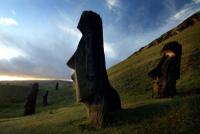 Easter Island, called Rapa Nui by its inhabitants, famous for its massive stone statues, is one of the most remote inhabited islands in the world. It is almost 2,000 nautical miles from the coast of South America and over 1,000 nautical miles to Pitcairn, the closest inhabited island.
Easter Island, called Rapa Nui by its inhabitants, famous for its massive stone statues, is one of the most remote inhabited islands in the world. It is almost 2,000 nautical miles from the coast of South America and over 1,000 nautical miles to Pitcairn, the closest inhabited island.
Despite the distance, recent DNA analysis suggests that sailors were traveling back and forth between Rapa Nui and South America several hundred years before the the island was first visited by Europeans. In this week’s issue of Current Biology, researchers argue that the DNA points to contact between Native Americans and Easter Islanders between 1300 C.E. and 1500 C.E, three centuries after Polynesians settled the island and at least two centuries before Europeans first landed on the island in 1722. “We found evidence of gene flow between this population and Native American populations, suggesting an ancient ocean migration route between Polynesia and the Americas,” said geneticist Anna-Sapfo Malaspinas of the Center for GeoGenetics at the University of Copenhagen, who led the study.
But did the South Americans sail to Rapai Nui or did the Polynesians sail to South America? Opinions vary. As reported in Science:
But did Polynesians land on South American beaches, or did Native Americans sail 3500 kilometers into the Pacific to reach Rapa Nui? “Our studies strongly suggest that Native Americans most probably arrived [on Rapa Nui] shortly after the Polynesians,” says team member Erik Thorsby, an immunologist at the University of Oslo. He thinks that could support the controversial theory, posited by Norwegian adventurer Thor Heyerdahl more than a half-century ago, that Native Americans had the skills to move west across the Pacific.
But many scientists say that Pacific currents and Polynesian mastery of the waves make it more likely that the Polynesians were the voyagers. They may have sailed to South America, swapped goods for sweet potatoes and other novelties—and returned to their island with South American women.
